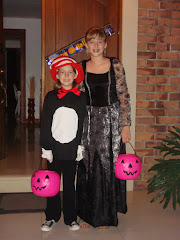 Of course there wasn't a traffic cop in sight, so in a completely haphazard way, all the drivers just started bullying their way around the two lanes to head toward the nearest exit.
Of course there wasn't a traffic cop in sight, so in a completely haphazard way, all the drivers just started bullying their way around the two lanes to head toward the nearest exit.Angie deftly manuevered her car around. I was impressed
 with her staying cool under pressure, and soon we joined three other "lanes" of traffic trying to get onto a one-way exit that would take us into San Jose. If the weather had been clearer I would have had some excellent photos, but this was the best I could do in the rain.
with her staying cool under pressure, and soon we joined three other "lanes" of traffic trying to get onto a one-way exit that would take us into San Jose. If the weather had been clearer I would have had some excellent photos, but this was the best I could do in the rain.We later learned that severe wind gusts knocked a bunch of trees across the road, causing the chaos. Turning around, driving the wrong way on one of the busiest, biggest highways in the country ... it was weird, but honestly, Angie and I both agreed that sometimes this stuff doesn't faze us so much anymore. The unusual is usual, the surreal is real, and traveling in this country is always an adventure!
Not to be deterred, we made it to the museum (some might consider this a feat in itself considering the lack of road maps and street signs) without further incident. We visited the Museo de Arte y Diseño Contemporáneo (Museum of Contemporary Art and Design) to see the World Press Photo exhibit. The museum is housed along with a theater in the Centro Nacional de la Cultura (CENAC—National Center of Culture) building which, interestingly enough, used to be the national liquor factory.
 I wish I had better pictures to show you of San Jose, but I only took a few since we just wanted to get out of the rain. The museum is across from the beautiful Parque España (Park of Spain). This spot of land is densely packed with oodles of amazing trees transplanted from all across Costa Rica. (The massive one in the photo is right across from the entrance to CENAC.) We also saw a bust of Queen Isabella of Castile and an unusual tiled guardhouse on the corner.
I wish I had better pictures to show you of San Jose, but I only took a few since we just wanted to get out of the rain. The museum is across from the beautiful Parque España (Park of Spain). This spot of land is densely packed with oodles of amazing trees transplanted from all across Costa Rica. (The massive one in the photo is right across from the entrance to CENAC.) We also saw a bust of Queen Isabella of Castile and an unusual tiled guardhouse on the corner.We entered the museum through the back entrance which doesn't look quite as grand as the front (but was closer to our parking spot).

 Across the street from the park is the Casa Amarilla (Yellow House), which used to be in Cartago (the previous capital of Costa Rica) until it was destroyed in an earthquake. It was then rebuilt in SJ in 1912 and is home of Costa Rica's foreign ministry. It's a national monument, and we wanted to go inside to see the interior but it was closed. You can see on the edge of the photo, left-hand side, a huge Ceiba tree which was planted in 1963 by John F. Kennedy and the presidents of all the Central American countries.
Across the street from the park is the Casa Amarilla (Yellow House), which used to be in Cartago (the previous capital of Costa Rica) until it was destroyed in an earthquake. It was then rebuilt in SJ in 1912 and is home of Costa Rica's foreign ministry. It's a national monument, and we wanted to go inside to see the interior but it was closed. You can see on the edge of the photo, left-hand side, a huge Ceiba tree which was planted in 1963 by John F. Kennedy and the presidents of all the Central American countries.Lastly, we couldn't help but notice banners and flags flying from buildings all across the city. September 15 is Independence Day here in Costa Rica, and the Ticos love to show their national pride.




1 comment:
what an adventure you two had! And at the end of it all you got to your destination in one piece and were able to enjoy what you set out to do. I love the history with this!
Post a Comment